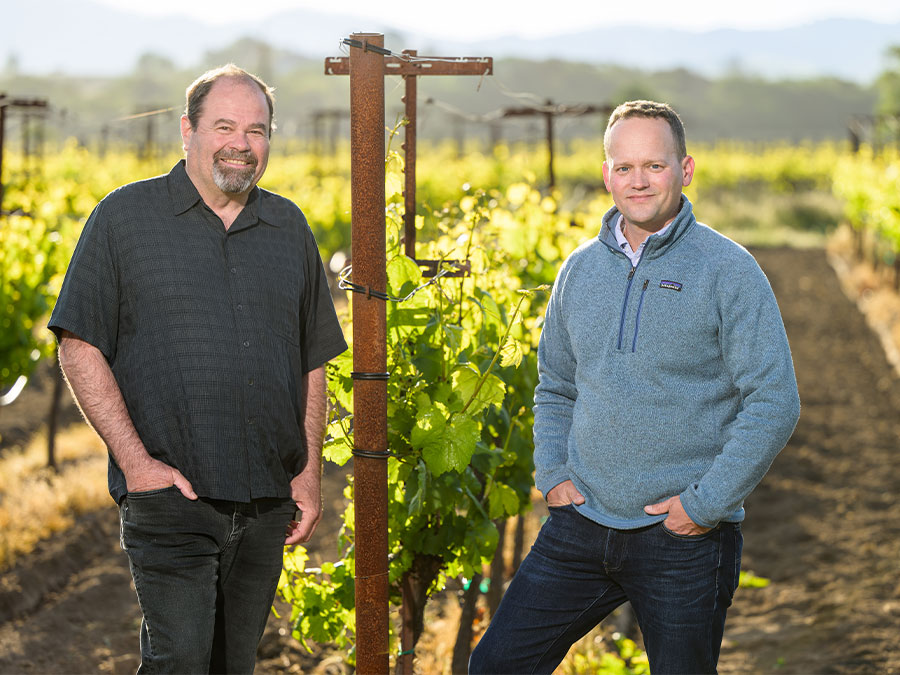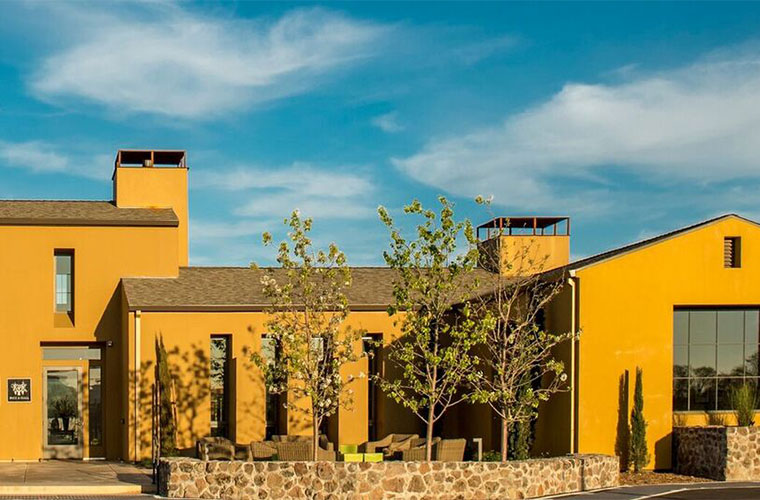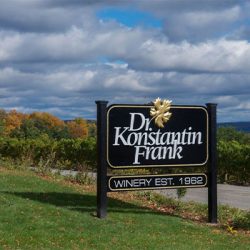

This week, James Hall bought back Patz & Hall from Ste. Michelle Wine Estates. Hall founded the brand in 1988 with his wife Anne Moses and Don and Heather Patz, and had sold to Ste. Michelle in 2016. Later, in 2021, Sycamore Partners, a private equity company, purchased Ste. Michelle and soon began to sell off assets. including its California properties. Hall saw the opportunity to reclaim his brand. Call it a de-consolidation: it’s a rare story of a family taking back the winery it had once built.
I’m longtime friends with James and Anne, and reached them by phone as they were arriving in Alsace for a few days of tastings, after a week in Burgundy for the Grands Jours de Bourgogne. Hall, the voluble son of an English professor, was ebullient as news of the purchase was announced this week. After checking with a source at Ste. Michele to confirm a few details, this interview was edited for clarity and length. —Patrick J. Comiskey
So congratulations to you both!
Thank you! It’s kind of amazing how things have worked out.
So back in 2016, Ste. Michelle purchased Patz & Hall. At the time, it seemed like both halves of the partnership were ready to retire. You, in fact, did not, and recently became ‘emeritus’ winemaker. Was retirement ever part of the original calculus?
No, it I would file it more under an offer too good to refuse. The circumstances were actually rather mundane. We had just completed a five-year plan when Ste. Michelle contacted one of our board members and said, “We’re trying to find a winery in Sonoma that makes chardonnay and pinot noir. And we’ve noticed that one name keeps cropping up on the Wine & Spirits list of most popular chardonnays in restaurants. Would you be interested in selling?”
And we all said, no, we’re not really interested. But our board chairman is like, “You know, guys, offers like these don’t happen very often. You really should consider taking a call or two and investigating.” And so we did.
At the end of the day it was a brilliant thing for us. I’m 95 percent sure we would have been put out of business by COVID. Sixty-plus percent of our accounts went out of business; we had just harvested the 2018 vintage, which was 23 percent over our initial crop estimate. And we were flexing a line of credit to get the grapes in the door and we would have bottled it in late 2019. It would have been a bloody disaster. We would have been sitting on a mountain of inventory as over half our accounts went dark, so, thank God we had Ste. Michelle who kept everyone employed and kept the winery open. They were like our white knight.
Tell me some of the ways they swooped in to help.
Plenty of new equipment, a new wine press, new barrel racks (which require new forklifts). I could get any barrel I wanted to and they made me good with every contract I ever wanted. There was very little of what you’d call ‘interference,’ beyond production volumes. They’d specify what they wanted in terms of case volumes, which was fine by me. It’s exactly the sort of thing you want them to tell you.
[Patz & Hall became part of a small but prestigious group of California brands which contributed to a top-tier division, including the wines of Antinori, Antica, their Napa brand, Stag’s Leap Wine Cellars, Nicolas Feuillatte, Col Solare, and others. Anne Moses headed up the sales team for this group. “I had the best job title in the world,” says Moses, “I was ‘Director of Luxury.’”]
When Ste. Michelle is sold to Sycamore in October, 2021, (the sale was completed in 2022), how did that affect you?
Well, there was a lot of activity in Washington, personnel changes, and tumult among the leadership team, but none of that reached us in Sonoma. Administratively it was full speed ahead.
When did you learn that Patz & Hall might be going up on the block?
Probably when they sold Stag’s Leap. I knew Stag’s Leap was the most profitable brand in the portfolio and the heart of the California division; with Stag’s Leap leaving, we started to wonder, where did that leave Patz & Hall? So we had an inkling, but there was nothing explicitly said. The thing about wineries is you get a rumor of being sold and it can really mess up your distribution. But I was okay with that. I thought, “Well, here’s another chapter.” I’d half decided that I was going to retire. I was thinking I would become a 1099 consultant, help make the wines and develop my golf game.
When exactly was P&H put up for sale?
It was about eight months ago. It was clear it was going to happen and I thought well, if there’s a prospectus, you know, please send me one. And lo and behold, I was intrigued. I had a couple of people that were interested in forming a partnership and potentially buying Patz & Hall. And so, we got together and we’re like, “Hey, why not? Let’s make an offer.” And it was accepted. It’s all kind of mind blowing, frankly.
You didn’t expect it to be accepted?
Of course we were hopeful our offer would be accepted, but there were other, much larger wineries placing competitive offers. We couldn’t get in some extended bidding war. We had to carefully calculate what it would take to stand up as a fully independent winery with all of our employees, benefits, etc. This took quite some time, but gave us confidence that if we did win the bid we could be successful.
And so it worked!
I think maybe Ste. Michelle and Sycamore Partners were eager to see the brand succeed. Though this was strictly a strategic business decision on their part. Who knows? I’d like to think that there might have been a somewhat romantic element like, “We want to see Patz & Hall go into good hands and, and live a happy, happy life.”
Inasmuch as venture capitalists can be romantic…
Well, you know, they’re venture capitalists and they’re in the wine business, which right there sounds like an oxymoron.


So what are your plans to do with your new old winery?
We think there’s an opportunity to expand our Sonoma Coast chardonnay, particularly on premise and by the glass. We’ll also be redoubling our efforts with our wine club and events, as well as re-energizing the D-to-C program. But mostly, we will be holding the course, particularly with our fabulous group of small family growers while continuing to improve quality.
Who are your partners in this venture?
There are three of us. Between us we have more than 50 years of experience in the business in operation, sales, finance, management. They’re not silent partners; they’ll introduce themselves soon.
And the winemaking team is intact?
You know, when I moved to the emeritus role, I hired James McCeney as the Director of Winemaking. James and I have worked together since 2013. Actually he has passed his Masters of Wine exam; he’s currently writing his thesis, so, assuming they like his thesis, he will be a full-fledged MW by the end of 2024. And we’ve been in a tasting group for years together, since 2012. We’re good friends, he’s got an extraordinary palate, and he’s a brilliant guy.
It’s a remarkable thing, to take over a winery you founded 36 years ago.
I know! It’s kind of a rare thing, sort of the reverse of consolidation. I consider myself very, very lucky. The circumstances are such that the winery most probably would have gone to a much larger entity; I’m thrilled that we somehow pulled this off. I’m still shaking my head that it happened.
Patrick J. Comiskey covers US wines for Wine & Spirits magazine, focusing on the Pacific Northwest, California’s Central Coast and New York’s Finger Lakes.
This is a W&S web exclusive. Get access to all of our feature stories by signing up today.




















